5 - Clastic Rocks
1/34
Earn XP
Description and Tags
Name | Mastery | Learn | Test | Matching | Spaced |
|---|
No study sessions yet.
35 Terms
the rock cycle
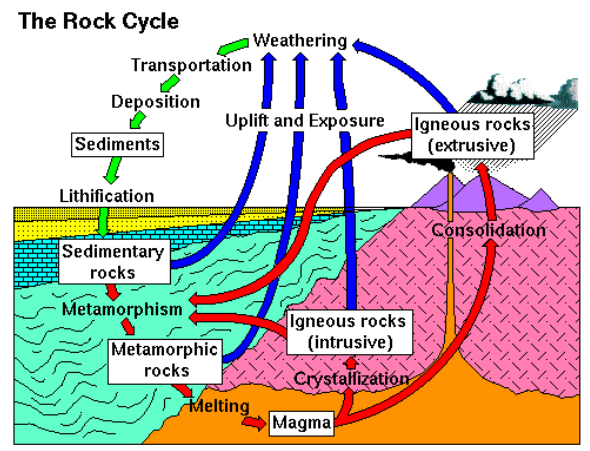
what are sediment?
loose material produced on the earth’s surface by erosion and weathering, or as the result of organic or inorganic precipitation in diff enviros
includes:
clays, silt, sand, gravel (siliciclastic)
shells (limestone)
evaporite minerals (evaporites)
how are sedimentary rocks formed?
by compacting and cementation of sediment
made up of small particles, stuck tgt w/ cement, w/ some pore space in bet
pore space usually filled w/ gas or fluid
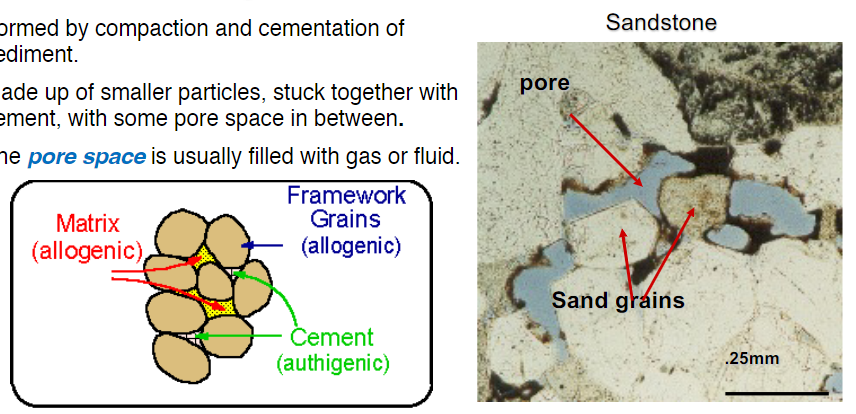
what is grain size?
card can be used to determine of sandstone is v fine, fine, medium, corase or v coarse
what is sorting ?
grain size distribution
sorting (well to poor)
can tell us deg of transport n reworking
poor sorting → close to source (proximal) little rework
well-sorted → farther from source (distal) more transport and reworking
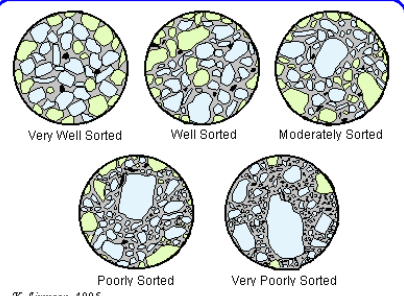
what is roundness ?
measures smoothness of corners and edges
better rounding indicates more transport and reworking farther from original source (distal)
beach gravel sorting and roundness?
well rounded and well sorted
what is textural maturity?
increase in rounding, sorting, and increase in stable minerals (e.g., quartz vs. feldspar and clay) is used to indicate a more “mature” enviro
supermature quartz arenites commonly reflect multi-cycle sediments
i.e., deposited and re-eroded

what are the sedimentary rock layers referred to as?
strata or beds
facts abt sediments and sedimentary rocks
cover abt 70& of earth surface
comprise only abt 5% of the vol of earth crust
contaim most of the world’s energy resources (oil, gas, and coal)
host most of the worlds subsurface aquifer’s
contain fossils tat document the history of the dev of life on earth
what are the major calsses of sedimentary rocks?
siliciclastic (terrigenous clastic)
chemical/biochem and carbonaceous
what are siliciclastic sedimentary rocks?
extraformational (allogenic)
involves weathering and breakdown of large rocks
transport usually involved
derived from the “rock forming” silica-rich minerals
quartz, feldspar, clay-mineral, and rock fragment
categories of siliciclastic rock?
conglomerate (<1% of all sedimentary rocks)
sandstone (20-25%)
mudstones/mudrocks/shales (siltstones and claystones 50%)
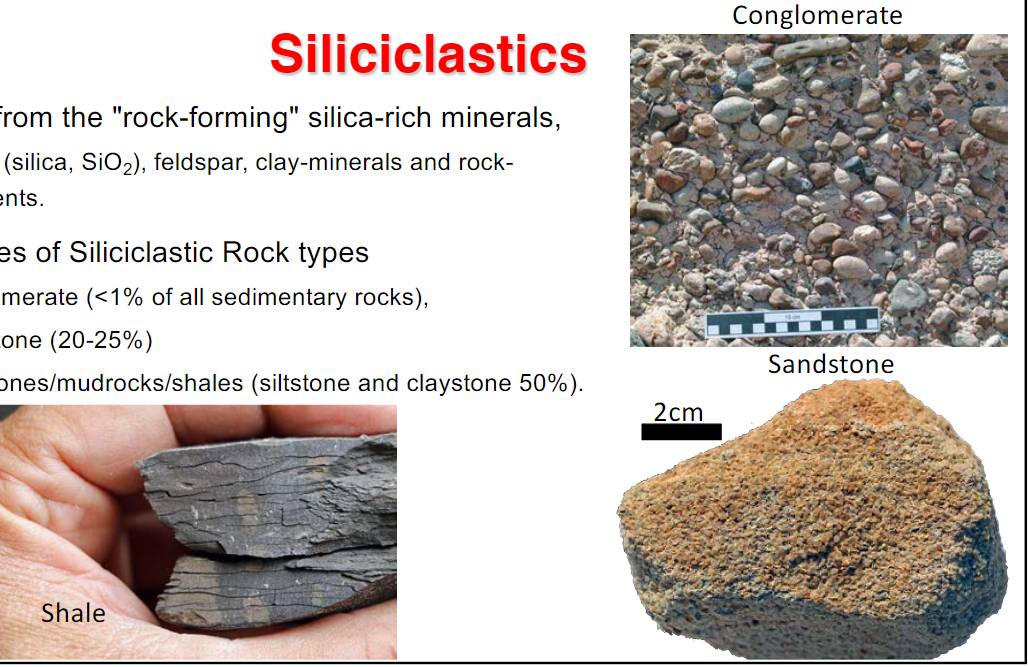
what are chemical/biochem and carbonaceous sedimentary rocks?
intraformational (autogenic)
usually formed as precipitate
may be organic in origin
carbonates (20-25%)
limestones Cac03
dolomites → ((Ca(Mg)Co3)
largely formed by shells of orgas
some inorganic chemical precipitation from fluids
TUFA, evaporite dolomite and limestone
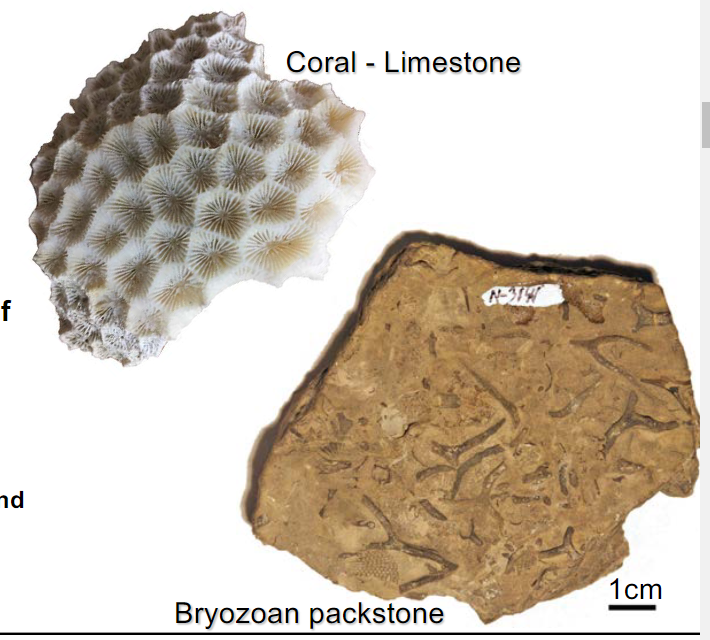
what are evaporite?
formed by chem precipitation from fluids (standing body ofw water)
gypsum (anhydrite, CaSO4)
rock-salt; halite (NaCl -salt)
sylvite (potash, KCl)
what is cherts?
siliceous oozes
radiolarian accumulations
sponges spicules
diatoms
diagenetic nodules D
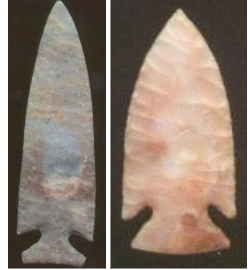
ironstones, phosphorites, fossil fuels?
ironstones
precambrain iron oolites
hematite (Fe2O3)
chamosite, chlorite, glauconite (iron silicates)
phosphorites
guano (bap poop), bone beds, nodules
mostly apatite
fossil fuels
coal, oil and gas
what is sedimentology?
classification and interpretation of the origin of sediments and sedimentary rocks
e.g., mechanics of sediment transport, origin of sedimentary struct
requires physics and understand of fluid flow and turbulence
study of cementation that transforms sediment to rock
may require geochem and interaction of sediments, rocks, n fluids
what are sedimentary structures?
fluid moves sediment as bedforms
e.g., ripples and dunes
flume work and study of modern flows (e.g., rivers) shows that bedforms scale to the flow properties (e.g., velocity, water depth) and sediment type
the understanding of the physics of sediment transport can used to to interpret ancient processes (water depth, velocities of flow)
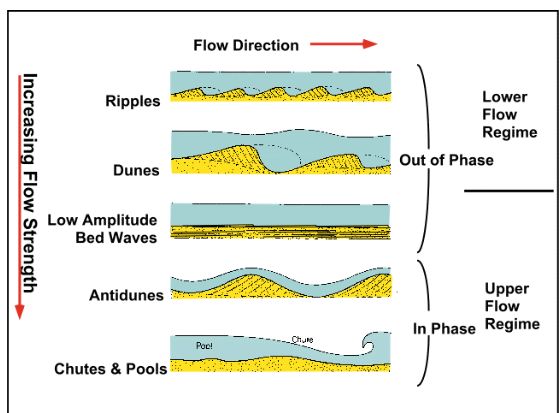
how can ripples form?
by water moving in one direction (current ripple)
or back and forth (wave ripple)
migration of ripples causes cross lamination
what are dunes?
larger bedforms, tens of cm to m in height and wavelength
scale to the depth of flow, flow velocity, and grain size
migration of dunes forms cross bedding
term “dune” does NOT imply formation by wind
dines can be subaerial or subaqueous
above vs. below water
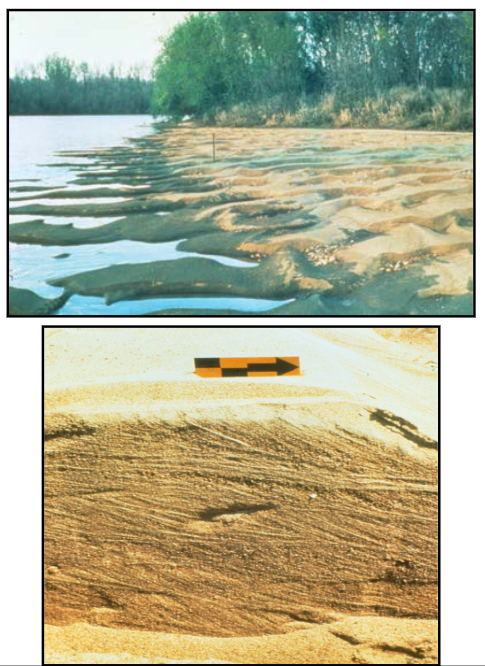
what are eolian dunes?
underwater (subaqueous) dunes form in the same way but by water vs. air
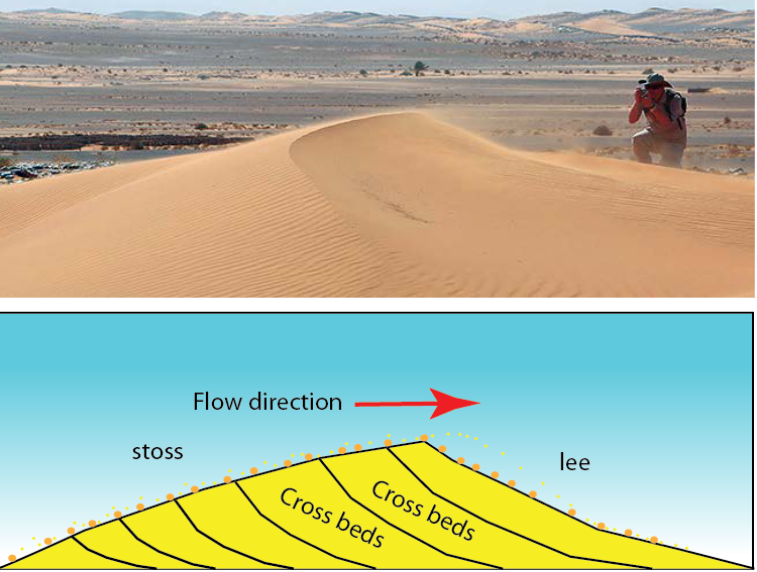
what is stratafication?
the product of processes active td are preserved in ancient sedimentary rocks → uniformitarianism
what are trace fossils?
are marks made by orgas as they crawl, burrow or rest in or on sediments
the study of trace fossils with a focus on sediment orgas interactions is called ichnology
a single orga may make several diff traces
the same trace fossils might be made by diff orgas
when looking at rocks, what is interpreted?
physical or chem process (i.e., hydrodynamics)
e.g., storm, flowing water in a river channel
place (i.e. enviro)
e.g., desert (aeolian), floodplain, reef, cold or hot climate
sedimentary enviros
enviros of deposition
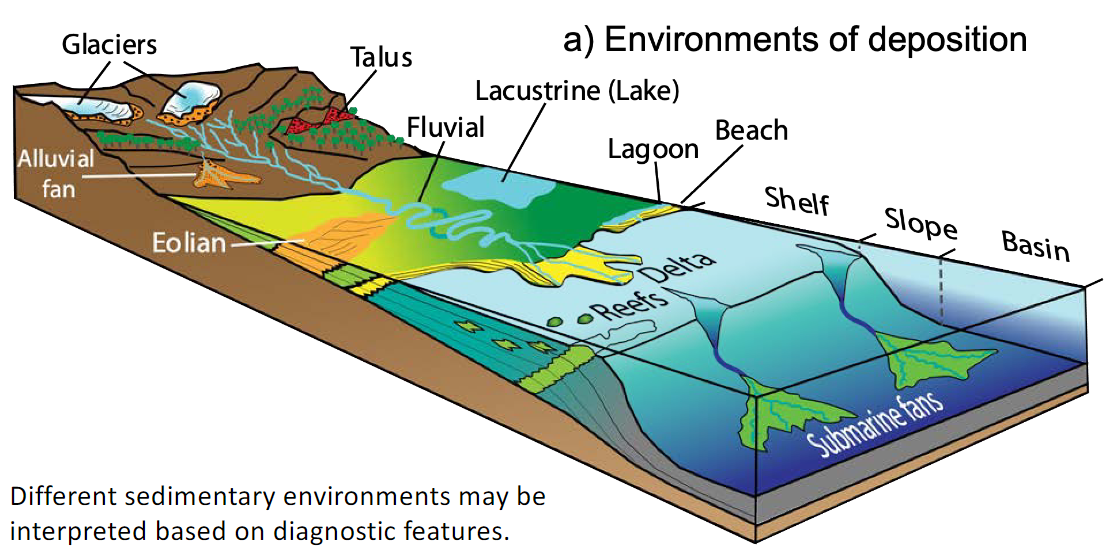
facies concepts
the sum aspect, appearance and characteristics of a sedimentary rock which arfe used to distinguish it from adjacent units and from the origin and the enviro of deposition may be understood
facies come from word face = appearance
categories
lithofacies, biofacies, ichnofacies, metamorphic facies
facies, sub-facies, micro-facies
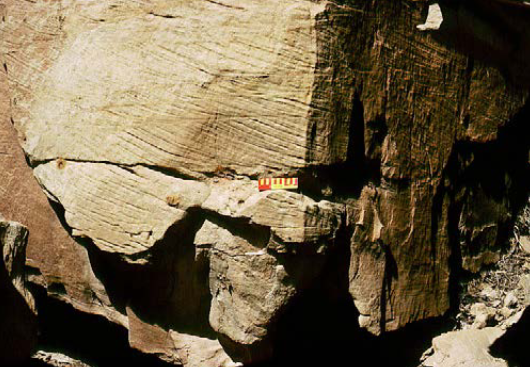
facies example
description:
medium grained, buff-coloured, cross stratified sandstone overlying mudstones containing fossil plants
interpretation
sandstone formed as dunes by unidirectional flow. plant material suggest sand deposited in a terrestrial river channel
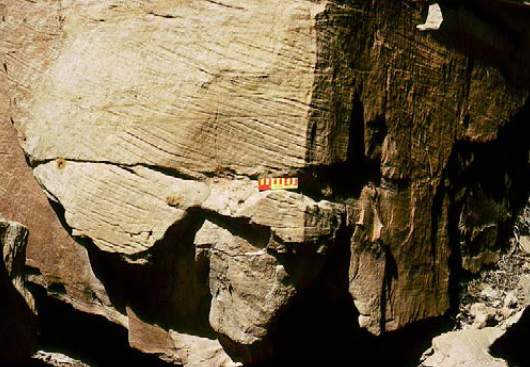
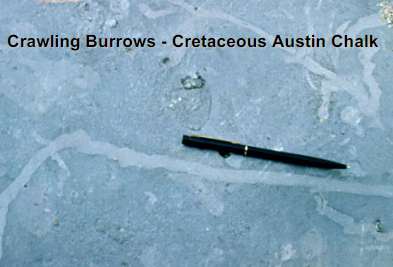
facies example - crawling burrows - cretaceous austin chalk
description
grey, bioturbated muddy limestone
interpretation
quiet water deposition in a shallow marine sea
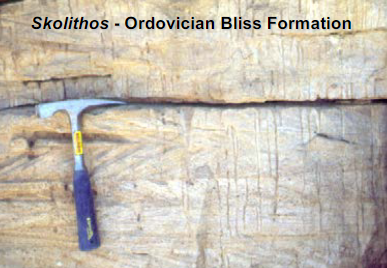
facies - skolithos
description
skolithos borrowed, tan-coloured, cross bedded sandstone. cross bedding dips in 2 directions
interpretation
desposition in a shallow marine sea characterized by strong tidal currents
facies - jurassic morrison formation Utah
description
red mudstone, cross stratified sandstones, erosional channel cutbank
interpretation
red mudstones indicate an arid floodplain
sandstone suggests a fluvial channel eroded into floodplain
what is Walter’s law?
“ only those facies and facies areas can be superimposed primarily that van be observed beside each other at the present time”
explains how the vertical stacking of facies relates to enviros that were laterally connected in the past
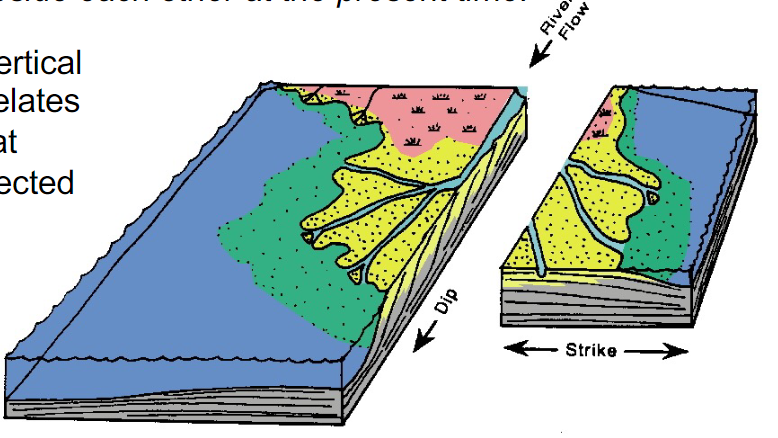
example of Walter’s law?
as shoreline migrate they produce a succession of facies that record the shallowing upwards
deposits coarsen upwards
delta front sands overlie silty foresets and muddy bottomsets
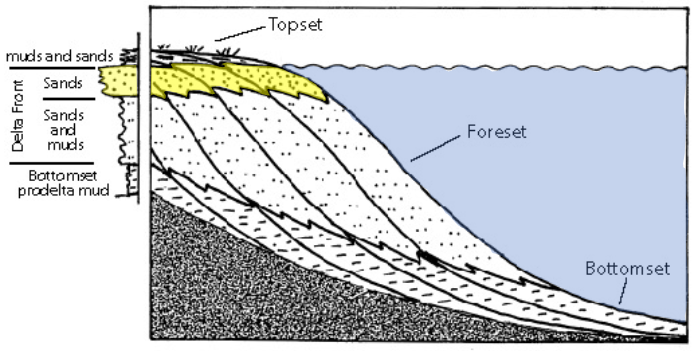
vertical measured sections
we use measured sections to characterize sedimentary deposits
in the case of rivers, sandstones are erosionally based
fining upwards facies successions are dominant
this records deposition during waning flows as rivers migrate across floodplains leaving their deposits behind
Walther’s Law facies successions
vertical association of facies characterized by a progressive change in one or more parameters
e.g.,
fining-upward channel fill succession
coarsening-upward prograding shoreface succession